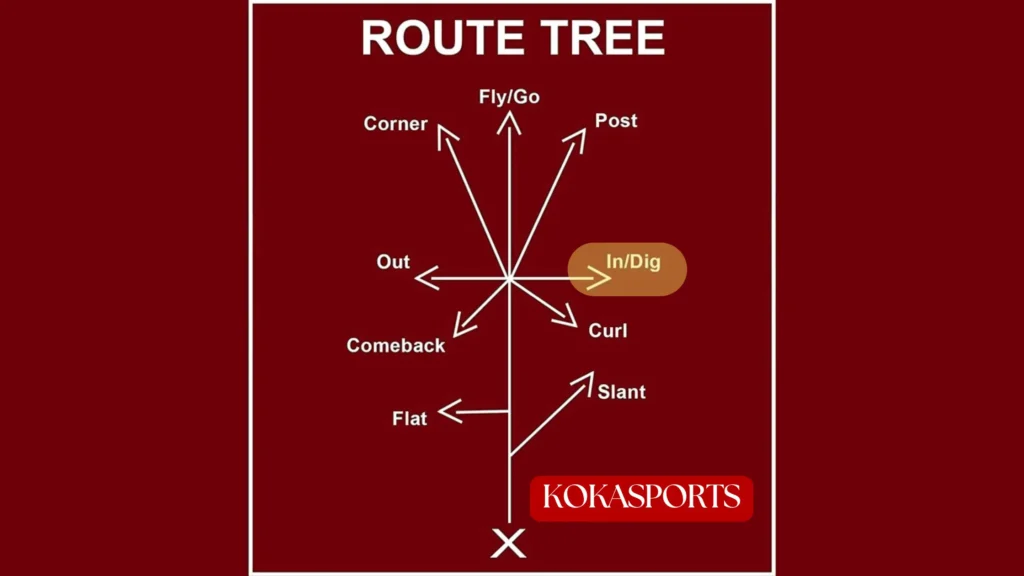If you’ve ever watched an NFL game and seen a receiver make a sharp cut toward the middle of the field after running 10-15 yards downfield, you’ve witnessed one of the most reliable passing plays in football. The dig route is a powerful weapon that coaches use to attack defenses and move the chains in critical situations.
What Is a Dig Route in Football?

The dig route in football is a medium-depth passing pattern where the receiver runs straight down the field for about 10-15 yards before making a quick, sharp cut toward the middle. Some coaches call it an “in route” or a “square in” because of how the receiver position changes direction across the field. This football route is designed to find open space behind linebackers but in front of safeties, making it extremely effective against zone coverage.
The typical dig route works like this: the receiver starts at the line of scrimmage, accelerates upfield to create separation from the defender, then plants their outside foot hard and breaks inside at roughly a 45-degree angle. The timing between the quarterback and the receiver must be perfect because the quarterback needs to throw the ball before the receiver completes their cut. This anticipation is what makes the dig route is often successful in high-pressure situations.
Key Characteristics of the Dig Route
The depth of a dig route is what separates it from other crossing patterns. While a drag route happens shallow across the field (usually 2-4 yards deep), the dig happens much deeper at 10-15 yards downfield. This extra depth gives the receiver time to create separation and find holes in zone coverage. The route is usually run by outside receivers, though slot receivers and even the tight end can execute it depending on the play design.
What makes this route so valuable is its versatility. Coaches can call it on second and long, third down situations, or whenever they need a reliable completion over the middle of the field. The dig route is one of the most practiced patterns in football because it requires precise route running and excellent chemistry between the quarterback and the receiver.
Read More: What Is a Defensive Lineman in Football? Complete Guide to Defensive Line Positions
How the Dig Route Fits in the Route Tree
Every offensive system in football uses a route tree to organize passing patterns. The route tree is a numbered system that helps players memorize and execute different routes quickly. Think of it as a map that shows all the possible directions a receiver can run from the line of scrimmage.
The dig route typically appears as a number 6 or 7 in most route tree systems, depending on the offensive scheme. It sits between shorter routes like the slant (which breaks at 3-5 yards) and deeper patterns like the post route (which angles toward the goal post). This placement makes sense because the dig operates in that medium-depth area that’s so crucial for controlling the passing game.
Comparing the Dig Route to Other Common Patterns
Let’s break down how the dig route compares to other popular patterns:
| Route Type | Depth | Direction | Best Use |
|---|---|---|---|
| Dig Route | 10-15 yards | Toward middle | Zone coverage, 2nd and long |
| Slant Route | 3-5 yards | Quick inside | Quick passes, man coverage |
| Post Route | 12+ yards | Toward goal post | Deep shots, single high safety |
| Corner Route | 10-15 yards | Toward sideline | Red zone, outside leverage |
| Curl Route | 10-12 yards | Back to quarterback | Soft zones, comeback situations |
| Drag Route | 2-4 yards | Shallow across | Underneath coverage, checkdowns |
The post dig route comparison is particularly important. While both routes start similarly with the receiver running straight down the field, the post route breaks at about a 45 degree angle toward the goal post for a deep shot. The dig route, however, cuts across horizontally to stay in that medium range. This makes the dig safer but still highly effective for moving the chains.
A slant happens much quicker and at a sharper angle right after the snap. The receiver takes 2-3 steps and breaks inside immediately. The dig requires patience – the receiver must run straight for much longer before making their break, which sells the vertical threat and freezes defenders deeper in coverage.
The comeback route and curl route both involve the receiver running upfield then turning around to face the quarterback, essentially breaking back toward the line of scrimmage. The dig keeps going forward across the field, maintaining that horizontal momentum that stretches defenses sideline to sideline.
How to Run a Dig Route Effectively

Executing a proper dig route requires excellent technique and timing. Here’s what makes a great route:
Technique and Mechanics
The receiver must start with a clean release off the line of scrimmage. Any delay from press coverage will throw off the entire timing of the play. As the receiver runs straight upfield, they need to sell the go route completely. This means keeping their eyes downfield, maintaining speed, and giving no indication that they’re going to run anything but a vertical route.
The break point is critical. At roughly 10-15 yards, the receiver plants their outside foot hard (right foot if running from the left side, left foot from the right side) and drives that knee back toward the middle of the field. The cut should be sharp, not rounded. Many young players make the mistake of curving their break, which allows the defender to stay in phase and make a play on the ball. A proper dig route features a 90 degree angle or close to it, creating instant separation.
Quarterback Timing and Anticipation
The quarterback can’t wait to see the receiver open before throwing. By the time the receiver completes their break, a good defensive back would have closed the window. The QB must anticipate the break point and release the ball while the receiver is still in their plant phase. This is why route combinations and practice reps are so important – the quarterback and the receiver need to be on the same page every single time.
Great quarterbacks in the NFL like Patrick Mahomes and Joe Burrow excel at throwing dig routes because they trust their timing and aren’t afraid to throw into tight windows. They know that if the throw is on time and on target, their receiver will be there to make the catch.
Beating Different Coverage Schemes
Against zone coverage, the dig route is similar to finding a seat in a crowded room – the receiver looks for the open space between defenders rather than trying to beat one specific person. In Cover 2, the dig attacks the area between the safety playing deep and the underneath linebacker. In Cover 3, it works in the void between the curl-flat defender and the deep middle safety.
Against man coverage, the dig route becomes more about winning with suddenness. The receiver uses their vertical push to stack on top of the defender, then snaps off their break with violence. If the defender’s hips are opening to the outside to protect against the corner route, the receiver can take advantage by cutting inside.
Route Combinations and Modern Applications

The dig route rarely exists in isolation. Smart offensive coordinators build route combinations that put defenses in difficult situations. Here are some popular pairings:
Dig + Post Concept (Mills): This classic NFL route combination features one receiver running a post route while another runs a dig underneath. The defense must choose – cover the deep post and give up the dig, or jump the dig and risk a touchdown on the post. This high-low concept has been a staple in NFL teams playbooks for decades.
Dig + Flat Route: This creates horizontal stretching. While one receiver drives 10-15 yards and breaks inside, another receiver (often running backs or a slot) runs a flat route toward the sideline at a shallow depth. The underneath defender must decide whether to carry the dig across or settle on the flat, creating one-on-one opportunities.
Dig + Corner Route: This gives the quarterback an outside-inside read. If the defender bails to protect the deep outside where the corner route is heading toward the sideline, the dig is open. If they stay short, the corner route clears behind them into the corner of the end zone.
Evolution in Modern NFL Offenses
Today’s NFL offenses have made the dig route even more dangerous by incorporating motion and tempo. Coaches like Sean McVay and Kyle Shanahan use pre-snap movement to identify coverage and create favorable matchups before the snap. When they see what they want, the dig becomes a high-percentage throw that consistently gains 12-15 yards.
Stars like Cooper Kupp and Justin Jefferson have made careers partially on their ability to run a dig route with precision. They understand how to set up defenders with subtle head fakes and speed changes. Kupp especially has mastered the art of the “sit dig” – where if the middle of the field is too crowded, he’ll stop his route in an open window rather than continuing across. This adjustment shows the intelligence required at the NFL level.
The route is also becoming more common in RPO (Run-Pass Option) packages. The quarterback reads the defense pre-snap, and if they see a favorable look for the dig, they’ll pull the ball and throw it. This evolution has made the dig route is often paired with run threats to keep linebackers honest and create even more space over the middle of the field.
Common Mistakes and How to Fix Them
Even experienced players can struggle with the dig route. Here are the most frequent errors:
Rounding the Break: This is the biggest mistake. When a receiver rounds their cut instead of making a sharp plant, they lose separation and allow the defender to stay in coverage. The fix is simple but requires discipline – plant hard, snap your head around, and drive across at a 90 degree cut.
Wrong Depth: Running the route at 8 yards instead of 12 yards might not seem like a big difference, but it completely changes the timing and throws off the quarterback’s release point. Receivers must hit their landmarks consistently. Using the yard markers on the field as reference points helps maintain proper depth.
Not Selling the Vertical: If the receiver gives away their intention to cut inside, the defender can jump the route for an interception. The receiver must make the defender believe they’re going to run a go route or post route. This means maintaining speed and keeping eyes downfield until the break point.
Poor Body Control: After making the cut, some receivers lose balance or have to slow down to stay on their feet. This kills yards after catch potential and makes them vulnerable to big hits. Proper footwork and core strength prevent this issue.
The Future of the Dig Route
As defenses continue to evolve with more exotic coverages and pattern-matching zones, the dig route remains relevant because it attacks universal principles of football – space and timing. Modern analytics have confirmed what coaches knew intuitively: medium-depth throws over the middle of the field offer the best balance of completion percentage and yards gained.
The route will continue adapting to new defensive schemes. We’re seeing more “choice digs” where the receiver to run has the option to break at different depths based on leverage. We’re also seeing tighter spacing concepts where multiple receivers run variations of the dig at different levels, creating a layered effect that’s nearly impossible to defend.
Youth and high school programs are teaching the dig route earlier because it represents core route running principles that apply to many different routes. The footwork, timing, and field awareness required for a good dig translate to success in other patterns.
Final Thoughts
The dig route is more than just another route in the playbook – it’s a fundamental passing concept that every successful offense must execute well. From the short route options like the hitch and slant to deep shots like the fade route or wheel route, the dig occupies that crucial middle ground that keeps drives alive and defenses honest.
Whether you’re a young player learning to run a go route and other basics, or a coach designing passing plays for your team, mastering the dig should be a priority. It’s a route where the receiver can showcase their skills, the quarterback can demonstrate trust and timing, and teams can consistently get open against any coverage.
The next time you watch an NFL game, pay attention to how often receivers usually run the dig pattern on key third downs. Notice how the best players in the league make it look effortless – receiver runs straight, plants, breaks, catches, and gains the first down. That simplicity, combined with the technical precision required, is what makes the dig route one of the most important routes in the passing game at every level of football.
FAQs
What are dig routes in football?
A dig route is when a receiver runs 10–15 yards downfield, then cuts sharply toward the middle of the field.
What is the difference between a dig route and a drag route?
A dig route is deeper, while a drag route is short and runs across the field underneath.
What is the hardest route in football?
The comeback or post-corner route both need perfect timing and sharp cuts.
How to do a dig route?
Run 10–15 yards upfield, plant, and cut hard toward the middle at a 45° angle.



